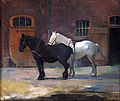Willy Reetz
Willy Reetz (born May 27, 1892 in Düsseldorf ; † July 24, 1963 there ) was a German painter . Occasionally the first name Wilhelm is given in the literature. The artist never used this himself, however, but signed all works with “Willy Reetz”.
Life
Reetz began his artistic career with an apprenticeship with a church painter. Then he attended the then highly renowned arts and crafts school . From 1912 Reetz studied at the Art Academy in Düsseldorf with Professors Willy Spatz and Franz Kiederich . From 1920 to 1924 he was a master student with Hans Kohlschein . Study trips took him to Holland, France and Italy. From 1924 Willy Reetz worked as a freelance artist.
Willy Reetz had an extraordinary talent for landscape, figure and portrait and initially turned very successfully to large-format wall painting, which had a rich tradition in Düsseldorf. The wall paintings in churches and secular buildings in Düsseldorf and the surrounding area showed his special mastery in this discipline: In 1927, together with Hans Kohlschein, he designed the frescoes in the church of St. Maria Rosenkranz in Düsseldorf-Wersten. In 1928/29 he won the competition for the painting of the Trinity Church in Düsseldorf and carried out this until the summer of 1929. Orders for St. Josef in Düsseldorf-Oberbilk, for churches in Süchteln, Galkhausen, Elberfeld and Sittard followed. In addition to the sacred wall paintings, there were also contradicting content, such as the Radschläger for Tigges am Brückchen on Düsseldorf's Königsallee or the Seven Swabian Stories in Schwabenbräu. In addition, Reetz also designed numerous glass windows and mosaics. Almost all of these works were destroyed by the bombs of World War II .
Another focus of his painting was portrait and landscape painting. He was a valued representative of the Düsseldorf School of Painting and enjoyed a high reputation, also beyond Düsseldorf. Numerous works still exist today in museums and private collections. These are not only of high artistic value, but also of particular exclusive value, because many designs, landscapes and portraits went down with his studio in a bombing night in 1943.
Reetz was a member of the artist group in 1949 and for 40 years a member of the Düsseldorf artists' association “Malkasten” . During the Second World War, he saved its valuable archive from destruction and, after the end of the war, played a decisive and committed role in its reconstruction.
Willy Reetz was a “modest, likeable painter, always a cheerful and witty companion among art lovers”, as a newspaper wrote on the occasion of his 70th birthday.
Works
literature
Reetz, Willy . In: Hans Vollmer (Hrsg.): General Lexicon of Fine Artists of the XX. Century. tape 4 : Q-U . EA Seemann, Leipzig 1958, p. 33 .
Web links
- Literature by and about Willy Reetz in the catalog of the German National Library
- Picture in the Stadtmuseum Düsseldorf
- Daughter: Beate Fröhlich, painter
| personal data | |
|---|---|
| SURNAME | Reetz, Willy |
| BRIEF DESCRIPTION | German painter |
| DATE OF BIRTH | May 27, 1892 |
| PLACE OF BIRTH | Dusseldorf |
| DATE OF DEATH | July 24, 1963 |
| Place of death | Dusseldorf |








